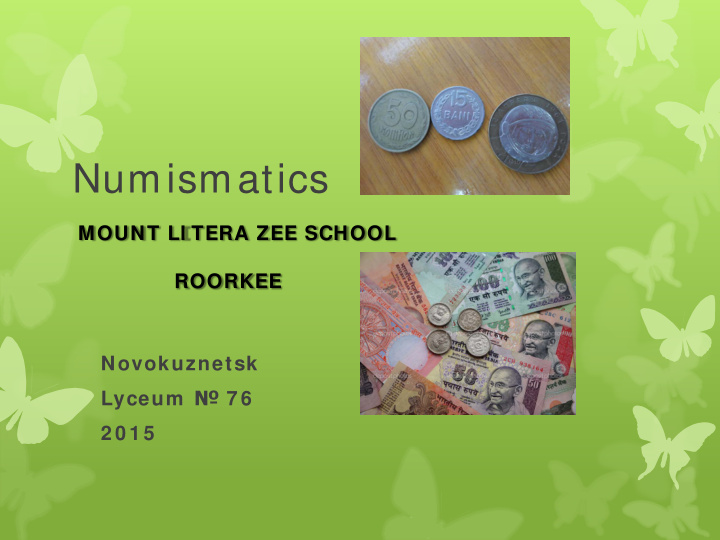



Numismatics MOUNT LI TERA ZEE SCHOOL ROORKEE Novokuznetsk Lyceum № 7 6 2 0 1 5
Numismatics What is a YN? Young Numismatists are junior collectors ages 5 to 17. Collect coins, learn about numismatic things, participate in auctions and make friends with the YN program. Sergey S. His mum’s collection
Numismatics Sergey V.
Numismatics
Money in India India's currency is the Rupee (INR), abbreviated Rs. One Rupee is made up of 100 Paise. Rupee notes come in denominations of 1, 2, 5, 10, 20, 50, 100, 500, 1000. Each note has its value written on it in 17 languages, including English. You can’t import or export Indian Rupees. Credit cards are becoming more and more common in India. Large hotels, shops, restaurants and also many service providers will accept international credit cards, such as American Express, MasterCard and Visa. They may require a minimum payment of Rs250, however.
Types of Money in India The rupee is the currency of India, although coins called "paise" still are in use. Paise are rare because the denomination is so small; 100 paise equals one rupee. It’s Rupees 5 or, to use the popular shorthand, Rs 5. Paper currency in rupees is available in denominations of Rs 5, Rs 10, Rs 20, Rs 50, Rs 100 and Rs 1,000. The rupee is the common name for the currencies of India, Sri Lanka, Nepal, Pakistan. The Hindi word rūpaya is derived form Sanskrit word rūpya , which means " a coin of silver" In most parts of India, the rupee is known as rupaya, rupaye, or one of several other terms derived from the Sanskrit rupya, meaning silver.
Markets Milk (regular), (1 liter) 41.41 Rs Loaf of Fresh White Bread (500g) 25.09 Rs Rice (white), (1kg) 47.56 Rs Eggs (12) 54.43 Rs Local Cheese (1kg) 268.46 Rs Chicken Breasts (Boneless, Skinless), (1kg) 199.69 Rs Buffalo Round (1kg) (or Equivalent Back Leg Red Meat) 289.72 Rs Apples (1kg) 127.44 Rs Banana (1kg) 44.61 Rs Oranges (1kg) 64.92 Rs Tomato (1kg) 31.13 Rs Potato (1kg) 24.53 Rs Onion (1kg) 33.62 Rs 1 INR = 0.96 RUB Lettuce (1 head) 30.71 Rs 1 RUB = 1.04 INR Water (1.5 liter bottle) 26.21 Rs
Famous Numismatists (Coin Collectors) Kings, queens, emperors, presidents, and other famous people are often featured on coins, either as head of state, and usually on the obvers or "head" side of coins, or sometimes honoured for some great achievement, usually on the "reverse" side of commemorative coins. However, throughout history a good number of famous people have also collected coins. Famous or important people who happen to be, or have been coin collectors. Famous coin collectors (numismatists) include the Roman emperor Augustus, Louis XIV of France, US President John Quincy Adams, and King Farouk of Egypt.
Famous Numismatists Augustus It was customary in Rome, as it also had been in Greece, to present coins as gifts on festive occasions, a tradition which Ovid recorded. The historian Suetonius (in Augustus 73) records that Emperor Augustus would distribute on the occasion of the Saturnalia festivities, among other precious gifts, various unknown foreign coins or coins with portraits of ancient kings " Tony Blair UK Prime Minister Tony Blair received a set of Russian coins, valued at £200, and was one of the few gifts which he kept personally. Under House of Commons rules, all gifts worth over £140 must be declared, and if the Member wishes to keep them, must pay the market value, over and above the first £140. We have e- mailed the Prime Minister's office to request a more complete specification of the coins, and await the reply with baited breath.
José Gerson da Cunha Cunha was an avid coin collector. He began collecting coins in 1876 and in addition to his own collection, purchased the collections of James Gibbs and Bhau Dhaji. By 1888, his personal collection had expanded to include over 27,000 pieces of Gold, Silver and other baser metals.[ 8] The collection of coins catalogued by Cunha was generally believed to be among the best in the British Empire.[ 6] This catalogue was published in Bombay in 1888. He wrote a book on numismatics, Indo- Portuguese Numismatics which was published in 1956 by Agencia Geral do Ultramar in Lisbon. This work is generally believed to be one of the few valuable studies in this field.
Pavel Zubov Pavel Zubov – one of the collectors numismatists famous in Russia, managed to make a unique collection of the ancient coins equal which didn't exist. There was this legendary collector from the provided family of the merchants which has become famous for generous patronage, to the monasteries directed on the help, temples, orphan houses and almshouses. Pavel's father also possessed the huge collection including unique ancient bow instruments.
More recommend